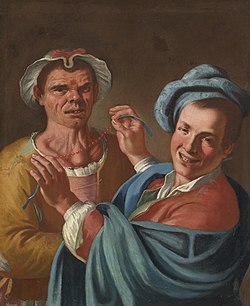
Domenico Cimarosa was an Italian composer of the Neapolitan School and of the Classical period. He wrote more than eighty operas, the best known of which is Il matrimonio segreto (1792); most of his operas are comedies. He also wrote instrumental works and church music.

Naples is the regional capital of Campania and the third-largest city of Italy, after Rome and Milan, with a population of 909,048 within the city's administrative limits as of 2022. Its province-level municipality is the third-most populous metropolitan city in Italy with a population of 3,115,320 residents, and its metropolitan area stretches beyond the boundaries of the city wall for approximately 30 kilometres.

Cybele is an Anatolian mother goddess; she may have a possible forerunner in the earliest neolithic at Çatalhöyük. She is Phrygia's only known goddess, and was probably its national deity. Greek colonists in Asia Minor adopted and adapted her Phrygian cult and spread it to mainland Greece and to the more distant western Greek colonies around the 6th century BC.

A gallus was a eunuch priest of the Phrygian goddess Cybele and her consort Attis, whose worship was incorporated into the state religious practices of ancient Rome.

Transvestism is the practice of dressing in a manner traditionally or stereotypically associated with a different gender. In some cultures, transvestism is practiced for religious, traditional, or ceremonial reasons. The term is considered outdated in Western cultures, especially when used to describe a transgender or gender-fluid person.

Leonardo Leo, more correctly Leonardo Ortensio Salvatore de Leo, was a Baroque composer.
The following outline is provided as an overview of and topical guide to transgender topics.

Neapolitan is a Romance language of the Italo-Romance group spoken in Naples and most of continental Southern Italy. It is named after the Kingdom of Naples, which once covered most of the area, since the city of Naples was its capital. On 14 October 2008, a law by the Region of Campania stated that Neapolitan was to be protected.

Francesco Fontana was an Italian lawyer and an astronomer.
Italian grammar is the body of rules describing the properties of the Italian language. Italian words can be divided into the following lexical categories: articles, nouns, adjectives, pronouns, verbs, adverbs, prepositions, conjunctions, and interjections.

Eduardo De FilippoOMRI, also known simply as Eduardo, was an Italian actor, director, screenwriter and playwright, best known for his Neapolitan works Filumena Marturano and Napoli Milionaria. Considered one of the most important Italian artists of the 20th century, De Filippo was the author of many theatrical dramas staged and directed by himself first and later awarded and played outside Italy. For his artistic merits and contributions to Italian culture, he was named senatore a vita by the President of the Italian Republic Sandro Pertini.
The primary languages of Calabria are the Italian language as well as regional varieties of Extreme Southern Italian and Neapolitan languages, all collectively known as Calabrian. In addition, there are speakers of the Arbëresh variety of Albanian, as well as Calabrian Greek speakers and pockets of Occitan.

Gender neutrality in languages with grammatical gender is the usage of wording that is balanced in its treatment of the genders in a non-grammatical sense. For example, advocates of gender-neutral language challenge the traditional use of masculine nouns and pronouns when referring to two or more genders or to a person of an unknown gender in most Indo-European and Afro-Asiatic languages. This stance is often inspired by feminist ideas about gender equality. Gender neutrality is also used colloquially when one wishes to be inclusive of people who identify as non-binary genders or as genderless.

The Four Days of Naples was an uprising in Naples, Italy, against Nazi German occupation forces from September 27 to September 30, 1943, immediately prior to the arrival of Allied forces in Naples on October 1 during World War II.
Ketty Gabriele is a reputed Camorra figure. Gabriele, a femminiello and member of the Camorra, was reported as the first transgender mafia figure following an arrest by Naples police in February 2009. According to authorities, Gabriele is a small-time capo behind a drug and prostitution ring for the Scissionisti di Secondigliano.
Gender systems are the social structures that establish the number of genders and their associated gender roles in every society. A gender role is "everything that a person says and does to indicate to others or to the self the degree that one is either male, female, or androgynous. This includes but is not limited to sexual and erotic arousal and response." Gender identity is one's own personal experience with gender role and the persistence of one's individuality as male, female, or androgynous, especially in self-awareness and behavior. A gender binary is one example of a gender system.
The Benevento dialect is a vernacular variety from the Campanian dialect that has undergone an evolution in a restricted space, roughly corresponding to the territory of the pontifical exclave of Benevento; this vernacular is placed side by side with other similar linguistic types referable to the same lineage and, in terms of phonetics, morphology and lexicon, it differs in some respects from Neapolitan.

Giuseppe, Antonio Pietro Cassella was an Italian astronomer, professor of Astronomy at the Naples University and first director of the Astronomical Observatory of Naples.

The history of cinema in Naples begins at the end of the 19th century and over time it has recorded cinematographic works, production houses and notable filmmakers. Over the decades, the Neapolitan capital has also been used as a film set for many works, over 600 according to the Internet Movie Database, the first of which would be Panorama of Naples Harbor from 1901.

The Vico, and Vicoletto, dei Zuroli, also called Vicolo dei Zurli are two historic alleys in the city of Naples, they are located near via Forcella in the historic center of the city, they are located near via Forcella and near the church of Pio Monte della Misericordia, between Via dei Tribunali and Via Vicaria Vecchia, in the Pendino district.
















